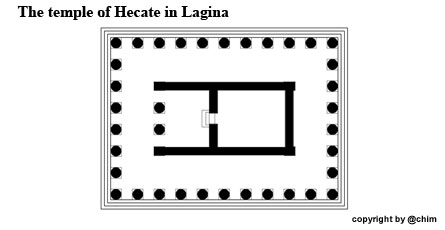|
The temple of Hecate, which was still very famous in Strabon's time, rose in an extensive sacred area surrounded by Doric porticoes.
The Cella, only 7 × 8 metres in size, was preceded by an almost 6 metre deep portico, Pronaos, of which a capital is preserved.
Two inscriptions were attached to the front of the antenna and the cella wall. The inscription on the cella wall is a Senatus consultum from 81 B.C. It deals, among other things, with treaty renewals between Rome and Stratonikeia and the granting of asylum to the Hecate shrine by Rome.
The temple probably had two construction phases. The first in the last third of the 2nd century BC, the second around 80 BC. |
|
|
In Greek mythology, Hecate is the goddess of magic, theurgy and necromancy. She is the goddess of crossroads, thresholds and transitions, the guardian of the gates between the worlds.
In Greek antiquity, Hecate became the goddess of witchcraft, magic and theurgy.
Her cult was rather cultivated in secrecy: As the ruler of magic, she was able to open access to the underworld and make contact with spirits and the dead possible, as oracle deity, reveal the future, grant power and wealth to their followers.
As a foreign goddess Hecate found no fixed place in the Greek Pantheon, her role was in conflict with already existing Greek deities, especially with Artemis. She became an elusive goddess of the domestic sphere and transitions. |
|




